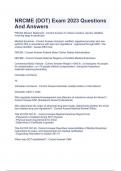Summary
samenvatting artikelen & boek Abboud (AVOV-Syrië)
- Course
- Institution
- Book
Dit is een samenvatting van de artikelen en het boek (Abboud-Syria) van het vak actuele vraagstukken van oorlog en vrede. In de samenvatting is alleen het artikel van Aljasem (college 4) niet behandeld, omdat dit een draft versie was waar nog niks uit gedeeld mocht worden.
[Show more]













